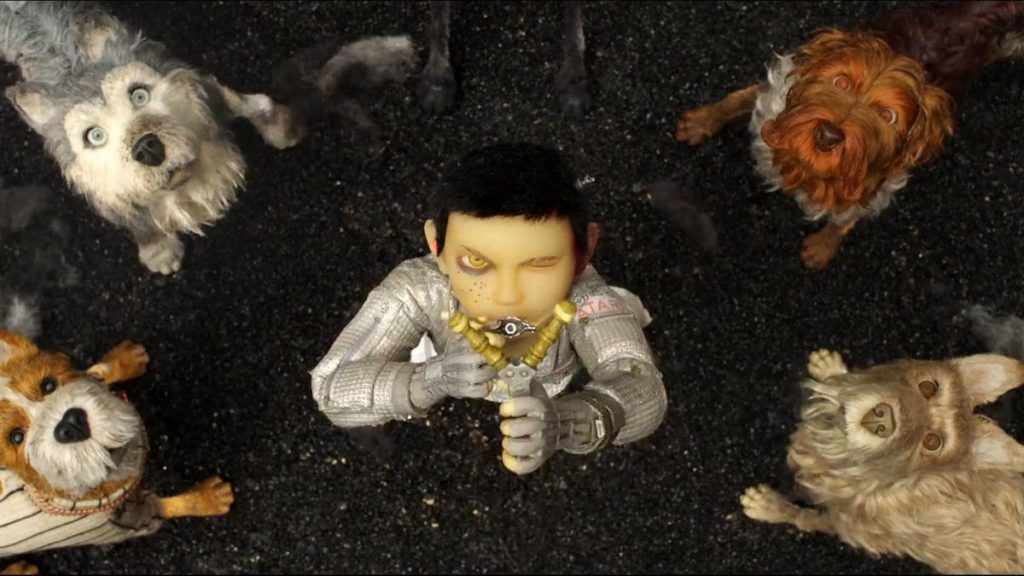First-day coverage of the 68th Berlin International Film Festival with a review of Wes Anderson’s stop motion animation Isle of Dogs
Isle of Dogs
Fans of Wes Anderson will find plenty to enjoy in Isle of Dogs, his second stop motion animation since the delicious Fantastic Mr. Fox (2009). Anderson’s trademark style is all here: the tracking shots, the limited color palette punctuated by intense red, elaborate sets full of details, and lots of symmetric shots usually with someone in the very middle of the frame staring straight into the camera. But his storytelling quirkiness is all the more adorable now than usual as he combines different types of animation and makes this a clear homage to Akira Kurosawa — yet you may wonder if his ambitions are just as impressive in terms of substance.
Anderson’s style is unmistakable, and he even begins his film with a humorous announcement to let us know that humans will be speaking in their characteristic “sounds” and dogs will have their language translated to English. The story takes place in Japan 20 years in the future, and Anderson inverts the roles by making us follow what the dogs are saying but not the Japanese humans (unless they speak English, of course). You know this is a genuine Wes Anderson movie when you see Japanese writing characters popping up on the screen with parenthetical subtitles in English, be in the credits or to describe actions and historical passages.
The first animated film to open the Berlinale, Isle of Dogs surprises not only with its stop motion but also the creative way it uses 2D drawings and graffiti on the wall in different contexts as well (like cartoons on TV monitors). The dogs look incredible with their breeds, personalities, voices (my favorites being Bryan Cranston and Harvey Keitel), and eye colors that sometimes match the background — and we can see their hair flickering in the wind too and a lot of emotion in their water-filled eyes. Some animated elements are even more amusing, like dog fights that turn into a cartoonish cloud ball, or a dog’s imagination appearing over his head inside a white balloon.
When the dogs become contaminated with a “canine flu” in this dystopian Japan, the humans ship them off (via cable car!) to a remote trash island that looks stunning with its architectural garbage (and one of my favorite sets is a colorful shelter made of bottles). In fact, the production design never ceases to impress with its power plants, pipelines and pagodas, while the beauty lies in the numerous delightful details, such as a colorful pattern created by flasks containing liquids of different colors on a laboratory shelf. The warm, fable-like cinematography is perfect in the way it complements and highlights all that is shown.
In the island, we follow stray dog Chief (Cranston) and ex-pets Rex (Edward Norton), Boss (Bill Murray), Duke (Jeff Goldblum) and King (Bob Balaban), who see their lives take a turn when a boy called Atari Kobayashi (Koyu Rankin) — nephew of Mayor Kobayashi (Kunichi Nomura), the man responsible for exiling the dogs — shows up to rescue his canine best friend Spots, “Dog Zero” of the epidemic. Chief, who refuses to be a pet, sees himself in a personal dilemma when he begins to develop an unexpected connection with Atari after the dogs decide to help the boy find Spots and escape the Japanese authorities who come to bring him back.
While clearly having a lot of fun with quirky narrative elements such as a Wasabi poison, a robot sniffer dog with digital identification, a simultaneous translator device, and even a cameo by Yoko Ono, Anderson seems to be a bit lost, though, with a wasted foreign exchange student, Tracy (Greta Gerwig), who doesn’t have that much to do until the end of the film and could have been voiced by anyone (it’s not like Gerwig’s persona adds to the character, after all). In fact, it’s obvious that Tracy is only American so that we can see people speaking in English with her (since the Japanese is mostly not subtitled), even though she does speak Japanese.
But my main problem with Isle of Dogs is that Anderson doesn’t fully explore the possibilities of his premise. Let’s face it, he has no intention of making this a political commentary, no matter how it may seem like it. Not that he should, but the result is a lot more harmless and unremarkable than it deserved to be, especially as the film ends up stating that basically every dog’s dream is to be owned and loved as a pet by humans, which completely betrays the very idea of revolution and equality. Still, the movie is pretty adorable as it is.





